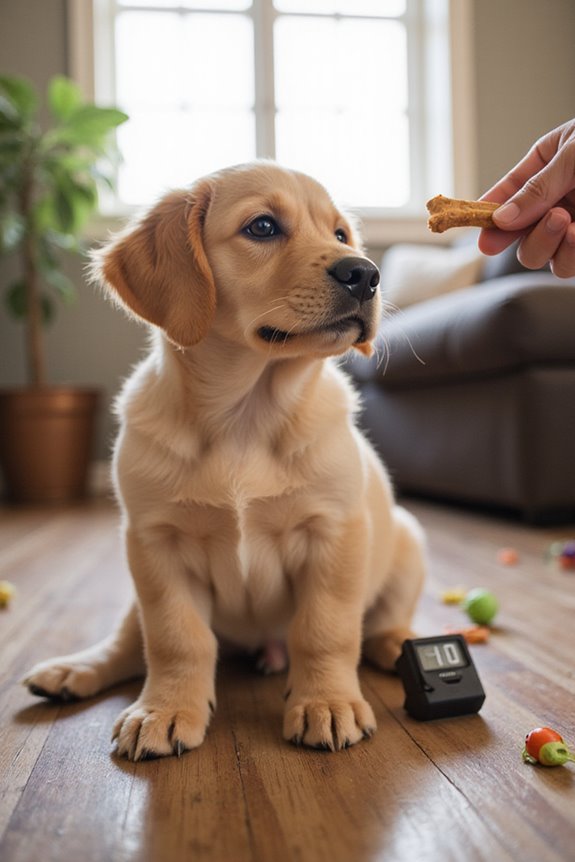Training sessions for dogs should be brief and focused, varying by age and attention span. For puppies, sessions should last 5 to 10 minutes, gradually increasing to 10 to 15 minutes as they grow. Young dogs benefit from 10 to 20-minute sessions, while adult dogs can handle 15 to 30 minutes. It’s essential to maintain quality interactions, so aim for one to two sessions daily, incorporating short training moments throughout daily life for best results. You’ll discover more on maximizing your dog’s training potential.
Key Takeaways
- Very young puppies require sessions of 5 to 10 minutes, increasing to 10 to 15 minutes as they grow.
- Young dogs benefit from training sessions lasting 10 to 20 minutes, while adult dogs can handle 15 to 30 minutes.
- Aim for one to two short training sessions daily for best effectiveness, focusing on quality over duration.
- Incorporate breaks to prevent burnout and maintain focus, adjusting session lengths based on the dog’s responsiveness.
- Utilize everyday moments for quick training opportunities, enhancing engagement and learning through play and positive reinforcement.
Understanding Dog Attention Spans
Understanding dog attention spans is essential for effective training and communication between handlers and their canines. Initially, a dog’s attention can last around 7 seconds, but with motivation—like treats or toys—they can sustain and even enhance focus. Here are some key points to take into account:
- Attention metrics vary by age, breed, and individual personality.
- Eye contact serves as a primary focus indicator during training sessions.
- Highly trained dogs tend to exhibit longer attention spans and more consistent eye contact.
As you work on building your dog’s attention span, remember that consistent training helps improve their focus capabilities. Keep sessions short and engaging, introducing varied activities to support their natural ability to concentrate while minimizing distractions. Incorporating positive reinforcement techniques can further enhance the effectiveness of your training sessions.
Ideal Session Lengths for Puppies

When training puppies, it’s important to recognize that their attention spans directly influence the ideal length of training sessions. For very young puppies, sessions should last around 5 to 10 minutes, helping maintain their focus and enthusiasm. As they grow older, you can gradually extend these sessions to 10 to 15 minutes.
To optimize your puppy training, consider the following tips:
- Aim for five to six short sessions per day, avoiding fatigue.
- Integrate quick training moments during potty breaks.
- Be flexible with session timing, adjusting based on your puppy’s mood.
- Always end on a positive note to encourage future engagement.
This approach guarantees effective puppy training and nurtures their natural curiosity.
Training Sessions for Young and Adult Dogs

Establishing effective training sessions for young and adult dogs requires attention to the unique needs of each age group. For young dogs, sessions should last between 10 to 20 minutes, considering their attention spans are influenced by puppy distractions. I recommend training 1 to 2 times daily, incorporating mental breaks to keep them focused.
In contrast, adult dogs typically tolerate longer sessions of 15 to 30 minutes. Their training can be divided into blocks or merged into a single session. It’s essential to prioritize adult focus during these times, ensuring quality interaction over duration. Pay attention to their energy levels; offering breaks helps prevent burnout, leading to more productive training outcomes.
The Role of Frequency in Training Success

The frequency of training sessions is a critical factor that can greatly impact a dog’s learning efficiency and long-term retention of skills. Research shows that:
- Dogs trained once or twice a week performed better than those trained daily, often mastering tasks with fewer total sessions.
- Weekly sessions allow for cognitive rehearsal, enhancing memory encoding and retention, which daily sessions can impede.
- While daily training might speed initial learning, it can dilute the quality of retention and increase total session requirements.
Balancing training frequency fosters skill acquisition without overwhelming your dog. Ultimately, infrequent yet focused sessions promote deeper learning, benefiting retention. Prioritizing training efficiency through spaced intervals guarantees your dog retains skills for the long haul, creating a stronger bond through successful learning.
Maximizing Learning Through Focused Sessions

Maximizing learning through focused sessions is essential for effective dog training, as it directly correlates with a dog’s ability to absorb and retain new commands. When I structure our training into short, intense 5 to 10-minute sessions, I harness the short session benefits that cater to my dog’s natural attention span. This focused learning helps keep him engaged, minimizing distractions while reinforcing one command at a time. In addition, wrapping up each session on a positive note increases his enthusiasm for future activities. Observing his body language allows me to detect when he’s losing interest, ensuring that our time together remains productive and enjoyable. Ultimately, these brief yet concentrated sessions greatly enhance his retention and enthusiasm to learn. Incorporating effective dog training clickers into these sessions can further amplify the positive reinforcement and communication during training.
The Impact of Session Duration on Learning Efficiency
Understanding how session duration affects learning efficiency is vital for optimizing dog training. Short training sessions, ideally limited to 5 to 15 minutes, guarantee that your dog remains engaged without succumbing to cognitive overload. Here’s why session duration matters:
- Attention Span: Dogs have concentrated attention spans, especially younger ones. Short bursts of intense learning keep them focused.
- Learning Retention: Longer sessions may lead to mistakes and frustration, hindering progress. Short, focused sessions enhance memory consolidation.
- Frequency vs. Duration: It’s often better to schedule 1 or 2 sessions per week rather than multiple daily ones. This balance creates an effective rhythm for learning.
Ultimately, maximizing session intensity while respecting your dog’s attention span is essential for efficiency and retention in learning.
Tailoring Training to Individual Dog Needs
While tailoring training to meet the individual needs of your dog may seem intimidating, it’s essential for effective learning and development. Understanding that different breeds and ages require customized training is vital. For instance:
- Puppies need shorter sessions, around 5–10 minutes, due to their limited attention spans.
- Older dogs may require slower-paced sessions that consider their energy levels.
- Dogs with anxiety or distractibility may benefit from modified session lengths and structures.
Be mindful of your dog’s mood; if they show signs of boredom or agitation, adjust the session accordingly. Consider individual learning styles; some dogs excel with multiple short sessions, while others thrive with fewer, longer ones. Tailoring training this way promotes engagement and enhances your bond with your dog.
Best Practices for Scheduling Training Sessions
Creating a structured schedule for training sessions is just as important as tailoring the training to meet your dog’s individual needs. Here are some best practices to take into account when scheduling:
- Session Timing: Aim for sessions lasting 10 to 15 minutes for basic commands. Puppies may require even shorter bursts, while experienced dogs can handle slightly longer sessions.
- Frequency: One to two short sessions daily works best. Multiple brief sessions spaced throughout the day are effective and maintain focus.
- Training Rewards: Combine commands with play and rewards, enhancing motivation and positivity.
- Adaptability: Adjust your schedule based on your dog’s responsiveness. If they show signs of fatigue or distraction, alter session length or frequency accordingly.
These strategies facilitate effective training while nurturing your bond with your dog.
Incorporating Training Into Daily Routines
Integrating training into daily routines offers a practical approach to reinforce commands and enhance your dog’s learning without demanding extensive time commitments. Here are some effective strategies to incorporate training throughout your day:
- Mealtime Training: Use mealtime for commands like “sit” or “wait” before feeding.
- Outdoor Activities: During walks, practice commands like “heel” and “leave it” to reinforce leash manners.
- Household Chores: Incorporate commands when doing chores, such as “leave it” while cleaning.
- Waiting Opportunities: Utilize moments at doors or in lines for quick obedience drills, fostering calm behavior.
- Socialization Exposure: Schedule regular social outings, integrating commands to build discipline in new environments.
These brief yet consistent training moments help maintain engagement and improve your dog’s skills naturally.
Recognizing Signs of Fatigue and Disengagement
Recognizing signs of fatigue and disengagement in your dog during training sessions is essential to ensuring effective learning and maintaining your pet’s well-being. Several fatigue indicators can help you identify when it’s time to pause, including:
- Decreased activity levels or unwillingness to continue exercises.
- Excessive panting or physical strain beyond normal exertion.
- Drooping ears, a lowered head, or a tucked tail indicating low energy.
Additionally, watch for disengagement cues, such as:
- Reduced responsiveness to commands.
- Loss of interest in treats or toys.
- Increased distractibility with surroundings.
Monitoring your dog’s behavior and adjusting session lengths accordingly can enhance their learning experience. Shorter, focused segments often yield better results, allowing your dog to engage positively while avoiding fatigue and disengagement.
Frequently Asked Questions
Can I Train My Dog While Playing Fetch?
Absolutely, I love using fetch techniques to train my dog! The training benefits are remarkable; it makes learning fun while we play. Just keep sessions short, and watch your pup thrive through our playful obedience practice.
Is There a Best Time of Day to Train My Dog?
When I think of training, morning sessions feel like fresh blooms, full of promise. Evening sessions, on the other hand, bring a warm glow. Timing can truly reveal a magic between us and our dogs.
How Can I Tell if My Dog Is Bored During Training?
I’ve noticed my dog’s body language speaks volumes about their engagement during training. If they’re yawning, avoiding eye contact, or fidgeting, it’s a clear sign I need to adjust our sessions for better focus and fun.
What Tools Can Help Me Track My Dog’s Training Progress?
Imagine a treasure map guiding us through our dog’s training journey. Using training apps and progress journals, I’ve captured each milestone, making every little achievement feel like discovering hidden gems together. Let’s celebrate our growth!
Should Training Sessions Vary Based on the Dog’s Mood?
Absolutely, I believe training sessions should change based on my dog’s mood indicators and energy levels. If she’s low on energy or uninterested, I adjust the length to keep her engaged and happy.



